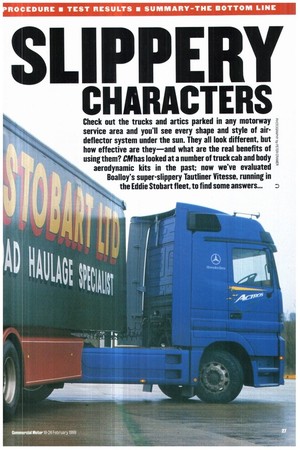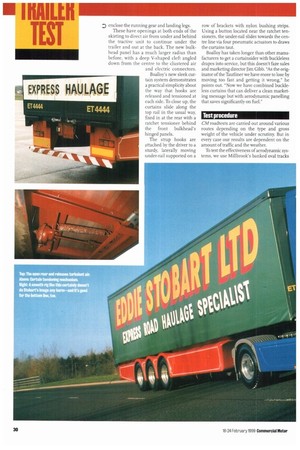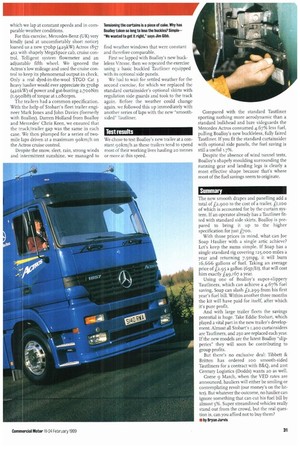PPERit
Page 29

Page 30

Page 32

Page 33

If you've noticed an error in this article please click here to report it so we can fix it.
CHARACTERS
Check out the trucks and artics parked in any motorway service area and you'll see every shape and style of airdeflector system under the sun. They all look different, but how effective are they—and what are the real benefits of using them? CMhas looked at a number of truck cab and body aerodynamic kits in the past; now we've evaluated Boalloy's super-slippery Tautliner Vitesse, running in the Eddie Stobart fleet, to find some answers...
ravel along any of our congested motorways and the commercial vehicles that really stand out are those with a
clean, streamlined appearance and eyecatching liveries. Leading transport groups such as TNT, Eddie Stobart and other household names place a high value on the marketing mes.sages that their curtains iders project—but they'd all like to get rid of the buckles and straps that interfere with the decals.
As well as keeping in the public eye, there's also a growing appreciation of the amount of fuel savings that an ultra-smooth outline can achieve. Even an improvement of a mere o.impg for each attic in a large fleet will add up to huge overall savings in a year.
This is clearly the real reason behind the joint development work on a new streamlined, buckleless Tautliner carried out with one of Boalloy's blue-chip customers, Eddie Stobart.
The Stobart fleet is huge. Some 1,200 of them are curtainsiders—and with a group diesel bill in excess of L20M, any improvement is worth investigating.
The new smoothie, called the Vitesse, has been under development for about two years; a prototype has been running in the Stobart
fleet long enough for both parties to become well satisfied with the results. So satisfied, in fact, that CM was invited to evaluate the new trailer against one of Stobart's standard Tautliner semis.
Aerodynamic equipment The new Tautliner Vitesse's most striking element is not so much the new bucldeless curtain system as the trailer's revised nose panel and shapely mouldings that surround and p enclose the running gear and landing legs. These have openings at both ends of the skirting to direct air from under and behind the tractive unit to continue under the trailer and out at the back. The new bulkhead panel has a much larger radius than before, with a deep V-shaped cleft angled down from the centre to the clustered air
and electric connectors. Boalloy's new sleek curtain system demonstrates a practical simplicity about the way that hooks are released and tensioned at each side. To close up, the curtains slide along the top rail in the usual way, fixed in at the rear with a ratchet tensioner behind the front bulkhead's hinged panels.
The strap hooks are attached by the driver to a sturdy, laterally moving under-rail supported on a
row of brackets with nylon bushing strips. Using a button located near the ratchet tensioners, the under-rail slides towards the centre line via four pneumatic actuators to draws the curtains taut.
Boalloy has taken longer than other manufacturers to get a curtainsider with buckleless drapes into service, but this doesn't faze sales and marketing director jim Gibb. "As the originator of the Tautliner we have more to lose by moving too fast and getting it wrong," he points out. "Now we have combined buckleless curtains that can deliver a clean marketing message but with aerodynamic panelling that saves significantly on fuel."
Test procedure CM roadtests are carried out around various routes depending on the type and gross weight of the vehicle under scrutiny. But in every case our results are dependent on the amount of traffic and the weather.
To test the effectiveness of aerodynamic systems, we use Millbrook's banked oval tracks which we lap at constant speeds and in comparable weather conditions.
For this exercise, Mercedes-Benz (UK) very kindly (and at uncomfortably short notice) loaned us a new 57ohp (429kW) Actros 1857 02 with shapely MegaSpace cab, cruise control, Telligent system flowineter and an adjustable fifth wheel. We ignored the Actros's low mileage and used the cruise control to keep its phenomenal output in check. Only a real dyed-in-the-wool STGO Cat 3 heavy haulier would ever appreciate its 57ohp (42okW) of power and gut-busting 2,700Nm (1,9 9 olbft) of torque at i,o8orpm.
The trailers had a common specification. With the help of Stobart's fleet trailer engineer Mark Jones and John Davies (formerly with Boalloy), Darren Holland from Boalloy and Mercedes' Chris Keen, we ensured that the truck/trailer gap was the same in each case. We then plumped for a series of twomile laps driven at a maximum 9okm/h on the Actros cruise control.
Despite the snow, sleet, rain, strong winds and intermittent sunshine, we managed to
find weather windows that were constant and therefore comparable.
First we lapped with Boalloy's new buckleless Vitesse, then we repeated the exercise using a basic buckled Tautliner equipped with its optional side panels.
We had to wait for settled weather for the second exercise, for which we replaced the standard curtainsider's optional skirts with regulation side guards and took to the track again. Before the weather could change again, we followed this up immediately with another series of laps with the new "smoothsided" Tautliner.
Test results
We chose to test Boalloy's new trailer at a constant 90km/h as these trailers tend to spend most of their working lives hauling 20 tonnes or more at this sped. Compared with the standard Tautliner sporting nothing more aerodynamic than a standard bulkhead and bare sideguards the Mercedes Actros consumed 4.67% less fuel, pulling Boalloy's new buckleless, fully faired Tautliner. If you fit the standard curtainsider with optional side panels, the fuel saving is still a useful 1.7%.
Despite the absence of wind tunnel tests, Boalloy's shapely moulding surrounding the running gear and landing legs is clearly a most effective shape because that's where most of the fuel savings seem to originate.
Summary
The new smooth drapes and panelling add a total of £2,900 to the cost of a trailer, Li,roo of which is accounted for by the curtain system. If an operator already has a Tautliner fitted with standard side skirts, Boalloy is prepared to bring it up to the higher specification for just koo.
With those prices in mind, what can Joe Soap Haulier with a single artic achieve? Let's keep the sums simple. If Soap has a single standard rig covering 125,000 miles a year and returning 7.5mpg, it will burn 16,666 gallons of fuel. Taking an average price of L2.95 a gallon (65p/fit), that will cost him exactly £49,167 a year.
Using one of Boalloy's super-slippery Tautliners, which can achieve a 4.67% fuel saving, Soap can slash £2,299 from his first year's fuel bill. Within another three months the kit will have paid for itself, after which it's pure profit.
And with large trailer fleets the savings potential is huge. Take Eddie Stobart, which played a vital part in the new trailer's development. Almost all Stobart's 1,200 curtainsiders are Tautliners, and 250 are replaced each year. If the new models are the latest Boalloy "slipperies" they will soon be contributing to group profits.
But there's no exclusive deal: Tibbett & Britten has ordered too smooth-sided Tautliners for a contract with B&Q, and 21st Century Logistics (Dodds) wants zo as well.
Come 9 March, when the VED rates are announced, hauliers will either be smiling or contemplating revolt (our money's on the latter). But whatever the outcome, no haulier can ignore something that can cut his fuel bill by almost 5%. Super streamlined vehicles really stand out from the crowd, but the real question is, can you afford not to buy them?
Eby Bryan Jarvis
















































































































